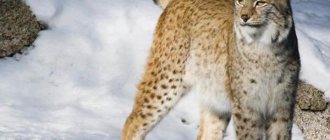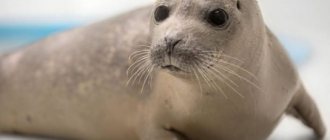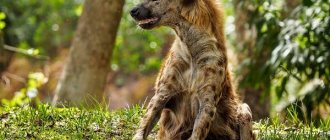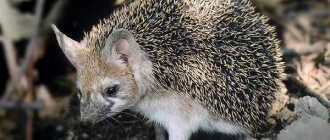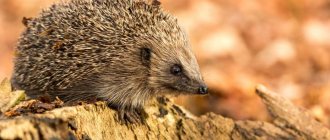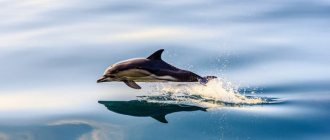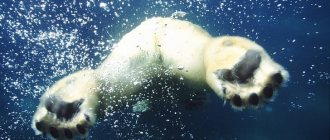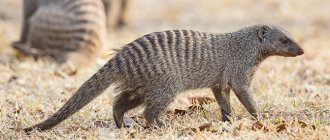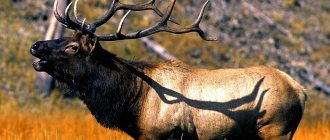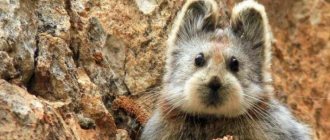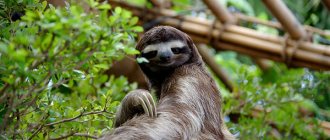Seals are a member of the seal family. Habitat: from Lake Baikal and the Caspian Sea to the Arctic Ocean and California. In each territory there is a certain subspecies of sea or freshwater seal. They are called seals, but seals are still different from other representatives of the large family.
A group of seals bask in the sun
Description of the Baikal seal
— Advertising —
The body length of the Baikal seal is about 160 cm. Growth continues up to 17-20 years (with an average life expectancy of 50-55 years). The weight of an adult animal is from 50 to 120 kg, maximum – 150 kg. The seal has long and thick fur that covers its entire body. It is missing only around the eyes and nostrils. Hair also grows on the flippers. The fingers are connected by membranes. The front paws have strong claws. The claws on the hind feet are smaller. There are vibrissae on the upper lip and above the eyes, which are longer in females than in males. The nostrils look like vertical slits. When the seal dives under water, special valves close its nostrils and ears. As you exhale, they open due to air pressure. The wool is gray-brown with a silver tint. The belly is usually lighter than the back.
The Baikal seal has well-developed hearing, vision and sense of smell. There is a third eyelid on the eyes. When exposed to air for a long time, the seal's eyes become watery. The fat layer is 10-15 cm thick. It is thinner only on the head and forelimbs, up to 1.5 cm. The fat protects the seal from cold and pressure changes when immersed in water. It makes it easier to float up and also serves as a food reserve.
Notes
- Galaziy G.I. Baikal in questions and answers. — 1989.
- The Ladoga seal (lat. Phoca hispida ladogensis
) lives in Lake Ladoga, and the Saimaa seal (lat.
Phoca hispida saimensis
) - a subspecies of the ringed seal - lives in Lake Saimaa. - Pastukhov V. D. Age and weight characteristics of golomyankas and pelagic gobies that make up the diet of the Baikal seal / V. D. Pastukhov, G. V. Starikov, S. A. Shalashov // Vopr. ichthyology. – 1969. – T. 9, issue. 6 (59). – pp. 1077–1088.
- Pastukhov V.D. Baikal seal / V.D. Pastukhov. – Novosibirsk: Nauka, 1993. – 271 p.
- Pastukhov V.D. Baikal seal as the last link in the production of the pelagic zone of the lake // Matter and energy cycle in lake reservoirs. – M.: Nauka, 1967. – P. 243–252.
- Pastukhov V.D. Nerpa as an indicator of the state of fish resources of Baikal / V.D. Pastukhov, A.P. Gladysh // Proc. report V All-Union. meeting limnologists. – Irkutsk, 1981. – P. 150–152.
- Pastukhov V.D. Long-term studies of phytoplankton and seals of Baikal as the basis for biological monitoring / V.D. Pastukhov, G.I. Popovskaya // Proc. report V All-Union. meeting limnologists. – Irkutsk, 1981. – P. 152–154.
- Pastukhov V.D. Features of the producing system of Baikal / V.D. Pastukhov, G.I. Popovskaya // Limnology of mountain reservoirs. – Yerevan, 1984. – pp. 233–234.
- Gurova L. A. Nutrition and food relationships between pelagic fish and seals / L. A. Gurova, V. D. Pastukhov. – Novosibirsk: Nauka, 1974. – 184 p.
- Outbreak of canine distemper in the Baikal seal / L. V. Baranova [et al.]; ed. Corresponding member RAS M. A. Grachev. – Novosibirsk: Nauka, 1992. – 70 p.
- Petrov E. A. Baikal seal: ecological and evolutionary aspect: abstract of thesis. dis. ...Dr.Biol. Sciences / E. A. Petrov. – Ulan-Ude, 2003. – 38 p.
- Petrov E. A. Baikal seal: ecological and evolutionary aspect: abstract of thesis. dis. ...Dr.Biol. Sciences / E. A. Petrov. – Ulan-Ude, 2003. – 38 p.
- Bogdanov L.V. New data on the taxonomic position of the Baikal seal Phoca (Pusa) sibirica Gmel. / L. V. Bogdanov, V. D. Pastukhov // Morpho-physiological and ecological studies of the Baikal seal. – Novosibirsk: Science, 1982. – P. 7–12.
- Amino acid sequence of Baikal seal myoglobin / G. I. Baram [et al.] // Bioorganic chemistry. – 1991. – T. 17, No. 9. – P. 1166–1171.
- Malikov N.G. Estimation of the time of divergence of seals Phoca vitulina, Phoca largha and Phoca sibirica from a common ancestral species / N.G. Malikov, M.A. Grachev, N.P. Mertvetsov // Zhurn. evolutionary biochemistry and physiology. – 1997. – T. 33, No. 2. – P. 252–254.
- Sasaki H. The origin and genetic relationships of Baikal seal elucidated by restriction analysis of mitochondrial DNA / H. Sasaki, K. Numachi // Animal Community, Environment and Phylogeny in Lake Baikal, 1997. – P. 91–105.
- Sasaki H. Low genetic variability of the mitochondrial DNA genome of the Baikal seal Phoca sibirica / H. Sasaki, E. Petrov, K. Numachi // Baikal - a natural laboratory for studying environmental and climate changes: abstract. report Intl. conf. (Irkutsk, May 11–17, 1994). – Irkutsk, 1994. – Part 5. – P. 66
Feeding characteristics of the Baikal seal
The diet of the Baikal seal includes omul, salmon and other Baikal fish, and crustaceans. The seal hunts on average at depths of 20 to 30 meters. In winter, the animal dives for prey to greater depths - up to 400 meters. A seal can survive under water without air for up to 25 minutes. An adult seal needs about 1 ton of fish per year.
general information
The general name of the aquatic species of mammals of the family of true seals (Caspian, ringed and Baikal) is seal.
The seal in Russia is distributed from the coasts of Murmansk to the Bering Strait, including in the waters of Franz Josef Land, Novaya Zemlya, Severnaya Zemlya, the White Sea and the New Siberian Islands. It inhabits the coastal parts of the Sea of Okhotsk, including its numerous bays, as well as the coastal areas of the Tatar Strait, Sakhalin Bay and Eastern Sakhalin. The seals' habitat reaches the shores of the Japanese island of Hokkaido.
There are also seals that live in fresh water reservoirs. For example, the famous Russian Lake Baikal is known all over the world not only because it is the deepest and most beautiful lake. Its waters are home to unique animals that are found nowhere else in similar reservoirs. This is a seal, which is endemic and a relict of the tertiary fauna. It is called the Baikal seal.
Distribution of the Baikal seal
The Baikal seal is endemic to Lake Baikal, namely its northern and middle regions, and is found occasionally in the south. In June, many seals are observed on the coast of the Ushkany Islands, as their natural rookeries are located here. At sunset, seals move en masse towards the islands. They are very curious, they can swim up to ships with the engine turned off and stay nearby, constantly surfacing.
Origin of the species
How and why the Baikal seal got into the deep-sea freshwater lake still remains a mystery. There are two hypotheses. According to one of them, it is assumed that the mammal, together with the Baikal omul, entered the reservoir during the Ice Age from the Arctic Ocean through the Yenisei and Angara, fleeing the advancing glaciers.
According to another assumption, pinnipeds first lived in European rivers and lakes, then expanded the boundaries of their range, settling in the Arctic Ocean, the Caspian Sea, and Baikal.
Only one thing is known for certain. The Baikal endemic has a common ancestor with the ringed seal. These species formed separate branches much later than the Caspian seal.
The first mention of the seal, dating back to the beginning of the 17th century, was recorded in the reports of explorers. A scientific description of the species during Bering’s second Kamchatka expedition was made by the leader of the detachment, I. Gmelin, who studied the surroundings of the lake and its inhabitants.
Behavior of the Baikal seal
The average speed of movement of the Baikal seal in water is 10-15 km/h.
Maximum speed – 25 km/h. The seals winter in dens under snow and ice. As the surface of the lake becomes icy, the seals make special vents, 1-2 m in diameter, and constantly remove ice from them so that the vents do not shrink.
When the lake is frozen, seals breathe only through these vents. Each animal's lair is surrounded by dozens of caves, except for one main and largest one. The vents are round, 10-15 cm in diameter, and the seal can lean into them for a breath of air. The vents expand downward and are funnel-shaped.
The ability to make vents in seals is an innate instinct. In an experiment with young seals, a small floating foam pad was installed on the water, while the rest of the aquarium remained open. Seals at the age of 1 and 2 months made holes in the foam, raked it with their claws from below, and breathed through such vents, despite the presence of open water nearby.
Ice breaking on Lake Baikal occurs from March to May. At this time, the Baikal seal moults. In summer, the animal comes to the shore, where it creates rookeries. During the molting period, the seal almost does not eat and does not go into the water.
Baikal seals sleep in the water, as they can remain motionless for a long time. Sleep can continue as long as the blood is sufficiently oxygenated. When the seal is sleeping, you can swim close to it, touch it and even turn it over, and the animal will continue to sleep peacefully.
How animals winter
In winter, Baikal seals live on the ice in dens dug in the snow. When Baikal begins to freeze, the animals make an unfreezing hole about 1.5 m long in the ice. They maintain it by constantly breaking off the growing ice. When severe frost sets in, seals sit in the water and inhale air through special holes made by their front flippers. Their diameter is about 17 cm - this is enough for a seal to stick its nose into it.
INTERESTING FACT T. The ability to make breathing holes is an innate feature. An experiment was conducted at the zoo: a large foam sheet was placed in a pool with baby seals. The kids raked the foam with their claws and made holes into which they inserted their noses to breathe air.
Baikal seal in the nerpinarium
Reproduction of the Baikal seal
Baikal seals become sexually mature at the age of 3-4 years, their first offspring appear at 4-7 years.
Puberty in males occurs 1-2 years later than in females. The duration of pregnancy is 11 months. During her life, the female gives birth to about two dozen babies, giving birth on average until she is 40 years old. Childbirth occurs every year.
Baikal seal cubs are born in a prepared snow den in February-March. This snow chamber is connected to the water by a special hole. A female has 1-2 babies in a litter, their weight is up to 4 kg. Baby seals are white in color, for this reason they are often called squirrels. For the first 4-6 weeks of life, the seal remains in the den and feeds only on its mother’s milk. At this time, he does not go outside and does not dive under water. Before the den is destroyed, the baby is completely moulted. The mother always takes care of the offspring, which she leaves only to go for food. When the female is inside the den, the temperature in it reaches +5 °C, and frosts outside at this time range from minus 15 to minus 20 °C. Males do not take any part in raising offspring.
Lactation in seals lasts 2-2.5 months. If the ice cover does not disappear, it may continue longer. After switching to independent feeding, the babies molt, their fur becomes silver-gray at 2-3 months, and later turns brown-brown.
2.Depending on the species, they can live in both salt and fresh water of arctic, subarctic or temperate zones.
3. Currently, three species of seal are known: two of them are marine, and one is freshwater.
4. All seals, especially freshwater ones, are living relics that have been preserved on Earth since the end of the Tertiary period.
5. Seals are similar to seals; they have a spindle-shaped body, a small head and limbs that have evolved into flippers, thanks to which seals swim and dive excellently.
6. The seal’s neck is poorly defined, sometimes it may even seem that it is not there at all, and the body simply turns into a small head with a flattened skull, smoothly turning into a slightly elongated muzzle.
7. In general, the shape of a seal’s head is somewhat similar to that of a cat’s, except that its muzzle is more elongated. The seal does not have ears; they are replaced by auditory canals, which are invisible externally.
8.The eyes of this animal are large, dark and very expressive. The eyes of baby seals seem especially large: huge and dark, they seem even more contrasting against the background of light fur and give the small seal a resemblance to either an owlet or some kind of alien creature.
9. Thanks to the third eyelid that seals have, they can swim and dive without fear of damaging their eyes. However, in the open air, the eyes of the seal tend to water, which gives the impression that the animal is crying.
10. The seal’s body has a large layer of fat, which helps this animal survive in the harsh conditions of a cold climate and not freeze in icy water.
11. These same fat reserves can help the seal survive a temporary hunger strike during the period of lack of food, and thanks to them the animal can lie for hours and even sleep on the surface of the water.
12. The skin of the seal is very durable and strong. It is covered with short, dense and stiff hair, which also protects the animal from hypothermia both in cold water and on ice or on the shore.
13. These animals have membranes between their toes, and on the front flippers, in addition, there are also powerful claws, thanks to which the seal makes holes in the ice in order to get out onto land or in order to rise to the surface of the water for a sip of fresh food. air.
14. The color of the fur of seals, depending on the species, can be dark silver or brownish, and it is often covered with darker spots.
15. There are three types of seals. The ringed seal inhabits the temperate waters of the Pacific and Atlantic Oceans and the Arctic Ocean.
16. In Russia, ringed seals are found in all northern seas, as well as in the Okhotsk and Bering Seas.
17. The Caspian seal is endemic to the Caspian Sea.
18.The Baikal seal is not found anywhere else in the world except Lake Baikal.
19. Some scientists suggest that all types of seals are related to each other by a common origin, and the ancestor of the Caspian and Baikal species is called the ringed seal, which migrated to Baikal and the Caspian about two million years ago and there evolved into two new species.
20. However, there is another version, according to which, the ringed and Baikal seals simply had a common ancestor, which appeared later than even the Caspian seal species.
21. All three species differ from each other in color and, partly, in size.
CASPIAN SEALS
22. The Caspian seal is the smallest of them, measuring approximately 1.3 meters in length and weighing about 86 kilograms.
23. The Caspian seal is found along the coastline and on the rocky islands of the Caspian Sea, and in winter it can also often be seen on drifting ice floes. In the warm season, it can even swim to the mouths of the Volga and Ural.
24. Caspian seals eat fish and crustaceans that live in the Caspian Sea. They are especially willing to eat small herring and sprat - these are the types of fish that make up the majority of their diet. The share of crustaceans is small - it is approximately 1% of the total amount of food.
25. One of the species of these animals, the ringed seal, was named so because of its unusual color, in which the dark rings on its skin have a light border.
26. The ringed seal, or akiba, is a species of true seal that is most often found in the Arctic: according to conservative estimates, there are about 4 million ringed seals in the world.
27. Akiba is distributed in the seas of the Arctic Ocean from the Barents and White Oceans in the west to the Bering Sea in the east, it lives in both the Seas of Okhotsk and the Baltic, the Strait of Tartar, the Gulf of Finland and Lake Ladoga, and sometimes rises along the Neva to St. Petersburg.
28. This seal lives both in the coastal zone and in the open ocean, but more often it lives in bays, straits and river mouths. This species does not make large regular migrations. In winter, the seal lives on the ice.
29.Subspecies of ringed seal: Baltic ringed seal, White Sea ringed seal, Ladoga ringed seal, Okhotsk or Far Eastern ringed seal, Saimaa ringed seal.
30.Ringed seal subspecies live mainly in polar or subpolar regions.
WHITE SEA SEAL
31. The White Sea seal lives in the Arctic and is the most common seal in the Arctic Ocean.
32. The Baltic seal lives in the cold waters of the northern regions of the Baltic, in particular, it can be seen off the coast of Sweden, Finland, Estonia and Russia. Sometimes this animal even swims to the coast of Germany.
33. Two other subspecies of ringed seals - Ladoga and Saimaa, are freshwater and live in Lake Ladoga and Lake Saimaa.
34. The body length of adult ringed seals reaches 1.5 meters, weight 40-80 kilograms. Baltic specimens are even larger - 140 centimeters and 100 kilograms. Males are usually somewhat larger than females.
35. Akiba has excellent vision, hearing and smell, which help the animal find food and hide from predators in time. These seals feed on crustaceans, mollusks and fish (spiny goby, Greenland goby, pike, navaga, salmon, salmon).
36.Ringed seals never form colonies. Most often they stay alone, although sometimes they gather in small groups, which, however, are not very stable. They spend the whole year at sea, for which their bodies are very well adapted.
37. The Baikal seal is not only endemic to Lake Baikal, that is, it is found only here, but the Baikal seal is the only mammal of Lake Baikal. According to morphological and biological characteristics, the Baikal seal is close to the ringed seal, which lives in the seas of the Far North and Far East. There are some signs of similarity between this seal and the Caspian species.
38. The origin of the seal in Baikal remains an unresolved issue to this day. Most researchers adhere to the point of view of I.D. Chersky that the seal entered Baikal from the Arctic Ocean through the Yenisei-Angara river system during the Ice Age simultaneously with the Baikal omul.
39.But there is another point of view - that the entire family of true seals, to which the Baikal one belongs, originated in large freshwater bodies of Eurasia. And only then did the settlement of three sister species begin: the Caspian seal mastered the Caspian Sea, the ringed seal - the Arctic Ocean, and the Baikal seal - the deepest freshwater lake.
40. However, there is no doubt that the seal owes its prosperity and high numbers in Baikal precisely to its deep water and the characteristics of its food webs.
BAIKAL SEALS ON THE USHKAN ISLANDS
41. The Baikal seal is distributed throughout the lake, but it is especially numerous in its northern and middle parts. The most favorite habitat of the seal is the Ushkany Islands, located on the territory of the Zabaikalsky National Park.
42. The basis of nutrition of the Baikal seal is golomyanka and gobies. She eats about a ton of fish a year. In search of food, the seal dives to a depth of 200 meters and remains under water for 20-25 minutes.
43. Previously, it was believed that Baikal seals cause great damage to the whitefish population, but, as it turned out later, they only catch them by chance and the total number of sturgeon fish in the seal’s diet is no more than 1-2%.
44. The seal is called a symbol of Baikal, the same as the famous Baikal omul, its images are used on emblems. This is an interesting object of ecological tourism.
45. Every year, many wildlife lovers come to Baikal to see and, if possible, photograph it. The main stream of ecotourists goes to the Ushkany Islands, where conditions for filming have been prepared.
46. It is believed that the Baikal seal has no natural enemies in nature: only humans pose a danger to it. However, it does not happen often that these animals are hunted by a brown bear.
BAIKAL SEALS
47. Baikal seal cubs are usually safely hidden inside the den, because in the absence of their mother, who has gone off in search of food, they can become prey for foxes, sables or white-tailed eagles.
48. The ringed seal, which lives in the ice of the Arctic, has many more enemies. It is seals that are the main part of the diet of polar bears, and arctic foxes and great polar gulls hunt their cubs. In the water, killer whales and Greenland sharks pose a threat to ringed seals. Sometimes walruses can also hunt them.
49. All seals are animals that lead a mostly solitary lifestyle. Only during the breeding season do they gather in flocks. But even at this, each seal tries to stay apart and drives away its relatives with an indignant snort.
LADOGA SEAL
50. The smallest among the subspecies of seals is the Ladoga seal, which lives in Lake Ladoga itself and has a body length of no more than 135 centimeters and a weight of 40 kilograms.
51. The seal spends most of its life in water. She is an excellent diver and can spend up to 70 minutes underwater, depending on the species. During diving, the animal's ear canals and nostrils are closed, so that under water it can breathe only thanks to the large volume of its lungs and the supply of air that fits in them.
52. Often these animals even sleep on the surface of the water, and their sleep is surprisingly sound: it happened that people, swimming up to sleeping seals, deliberately turned them over, and at the same time they did not even think about waking up.
53. The seal spends the winter under water, only occasionally rising to the surface of the water in order to take a new breath of fresh air. These animals begin to move out onto the ice or onto land closer to the beginning of spring, when the breeding season begins.
54. Moreover, as a rule, seals have favorite places for rookeries, where they gather in order to continue their race.
55. Seals only on land can seem like clumsy and clumsy creatures. In water, they are active, energetic and almost tireless. Underwater, the seal's speed can be 25 km/h, although in a calm environment these animals swim much slower.
56.On the shore, seals move with the help of their front flippers and tail, fingering them. If danger appears, they begin to jump, loudly slapping the ice or ground with their front flippers and pushing off the hard surface with their tail.
57. Sea seals of cold latitudes, unlike freshwater seals, regardless of the time of year, prefer to spend most of their time on ice or on the shore, rather than in the water, where they dive only in case of danger or in order to get food.
58. Sexual dimorphism is externally expressed in the fact that individuals of different sexes differ from each other in size. Moreover, if the Baikal seal has females that are larger than the males, then the Caspian seal, on the contrary, has larger males.
59.Depending on the species and gender, seals reach sexual maturity at 3-7 years of age, and males mature later than females. These animals give birth to cubs either annually or 2-3 years after the previous birth. Female seals usually give birth to one baby, but sometimes 2-3 babies are born at a time.
60. It happens that a certain percentage of females do not produce offspring after mating. As a rule, such “empties” occur in 10-20% of Baikal seals annually.
61. The reasons for this still remain unclear: either this is due to the natural regulation of the population level, or simply not all females that have temporarily suspended the development of the embryos resume it after some time. It is also possible that this phenomenon may be associated with some diseases suffered by the female or unfavorable living conditions.
62. Seals usually mate in the spring, and then the gestation period continues for 9-11 months. Females give birth on the ice, at which time they and their newborn cubs are very vulnerable to predators and hunters.
BELEK BAIKAL SEAL
63. The color of babies differs from the color of adults: for example, Baikal seal cubs are born white, which is where their name comes from - squirrels.
64. At first, the mother feeds the baby with milk, after which the baby is gradually transferred to an adult diet consisting of fish and invertebrates. By the time this happens, he has time to completely molt and change the color of his fur to that characteristic of adult individuals.
RINGED SEAL WITH CUB
65. Even before giving birth, Baikal seals build special dens out of snow, where they feed their cubs exclusively with milk for a month or a month and a half. Depending on weather and temperature conditions, lactation can last from 2 to 3.5 months.
66. The seal is the only animal that can deliberately suspend and resume the intrauterine development of its future cubs. Most often this happens during long and very cold winters, when babies born on time simply cannot survive.
67. Males do not take any part in raising their offspring, while females continue to take care of the babies until they learn to live independently. After the cubs are separated from the mother, the female seal can mate again, but sometimes the breeding season for her begins earlier: when the previous cub is still feeding on milk.
68. In summer, ringed seals stay mainly in coastal waters and in some places form small haulouts on stones or pebble spits. In autumn, as the sea freezes, most of the animals move from the coastal zone into the depths of the sea and stay on drifting ice.
69. A minority of animals remain off the coast for the winter and live in bays and bays. In this case, even at the beginning of the freezing of the sea, the seal makes holes in the young ice - holes through which it leaves the water.
70. There are also smaller holes, used only to breathe through them. Often the opening of the hole is covered with a thick layer of snow, in which the seal makes a hole without an exit hole to the outside. In such a convenient place she rests, being invisible to her enemies, mainly polar bears.
71. The seal is a valuable fishing object. It produces fur skins, fat and meat. Arctic foxes are fed seal meat, fur is used to make hats, and it is used to line hunting skis.
72. Seal meat is eaten, especially the tender meat of young seals, and seal flippers, boiled in water, are considered a delicacy. In ancient times, seal oil was used in tanning and soap making.
73. The seal fishery ultimately led to a reduction in the number of these animals. And, although every effort is currently being made to prevent seals from disappearing, one of their species is facing complete extinction.
74.Currently, two species of seals, the Baikal and ringed seals, are considered to be quite prosperous species and have been assigned the status of “Least Concern.”
CASPIAN SEAL
75. But the Caspian seal is not so lucky: due to human economic activities leading to pollution of the Caspian Sea, this species is in danger of extinction. And, although every effort is currently being made to restore the previous number of Caspian seals, their number is steadily decreasing from year to year.
76. Seals can live on average 40-55 years. Puberty occurs at 4-6 years of age. Females are able to bear fruit up to 35-40 years.
77.The age of seals can be easily determined by the annual rings on their fangs and claws. And this is their unique feature, not characteristic of any other animal in the world.
78. The largest concentrations of seals are observed in the spring on drifting ice during pupping, molting and mating. This is especially typical for the seas of the Far East, where in one day of sailing in the ice many hundreds and sometimes thousands of animals can be observed. Most often seals lie in groups of 10-20 animals, but there are clusters of a hundred or more animals.
79. Seals are amazing animals. They have a lively and curious character and are easy to train.
80.In natural conditions, they like to swim up to drifting ships and follow them.
photo from the Internet
Natural enemies of the Baikal seal
The Baikal seal population is stable and the animal is not under threat. This is due to the fact that in the food chain of the Baikal ecosystem, the seal is the top and none of the inhabitants of the lake hunts it. People remain the only source of danger for the seal.
Population and species status
It should be noted that two species of seals did not suffer a terrible fate and are considered safe species, with the status of “Least Concern”. The only unlucky person in this regard is the Caspian seal, whose numbers are decreasing from year to year. As a rule, this process is negatively affected by human activity, which leads to pollution of the Caspian Sea. For these reasons, the species is on the verge of complete extinction, despite the efforts being made to restore the numbers of these valuable animals. Unfortunately, the efforts being made are not enough and the population of the Caspian seal is declining at a rapid pace.
Seals have always been valuable to humans, so the main reason for the decline in numbers is fishing. Despite all efforts, in the near future only memories will remain of the Caspian seal. I would like to hope that this will not happen and that the person will do everything that depends on him.
Seals are amazing animals that are easy to train. This speaks of the lively and curious nature of this animal.
You can often see how seals swim up to ships and begin to watch them. The age of these animals can be easily determined by the annual rings formed on the claws and fangs. This fact is considered a unique feature of these living creatures.
Interesting facts about the Baikal seal:
- The Baikal seal fishery is associated with its valuable fur. The indigenous population also uses fat, meat and internal organs of the animal. But they have not found widespread use in the food industry.
- There is both legal seal hunting and poaching. The latter is associated with the harvest of seal calves that have passed their first moult (several months old), although such fishing has been prohibited by law for the last 40 years. The species is listed as critically endangered on the IUCN Red List.
About industrial production
The seal is an animal that contains large amounts of excellent fat, which has some beneficial medicinal properties. Commercial catch of seals today, as hundreds of years ago, pursues the same goals.
The fat of the animal is effectively used by many people in the treatment of certain diseases associated with hypothermia of the body (inflammation, frostbite), and its meat is used for food in cases of vitamin C deficiency (in particular, scurvy).
And yet, the main reasons for large-scale industrial production are the most valuable animal skins. Hats and clothing made of thick and dense fur with durable skin are widely popular both among residents of the North and in more southern regions.
Lifespan
The growth of the seal, both in length and in weight, occurs over a long period of time (up to 20 years). Some animals die “undergrown”, since their average age in the population is only 8-9 years. There are cases that some seals live up to 40-60 years, but there are very few of them. Approximately half of all individuals are young seals, approximately 5 years old. Older animals (6-16 years old) make up most of the other half of the seals.
The seal is an unusual animal in the sense that scientists have learned to determine its age by its fangs or claws, on which one can see annual rings, similar to those found on a cut tree.
Habitat and habits
As mentioned above, the main habitat of these cute predators is the Arctic and subarctic. Throughout most of their range, they use sea ice exclusively as a breeding, molting, and resting site. They crawl onto land rarely and reluctantly.
They lead an isolated lifestyle. They rarely gather in groups; this mainly happens during the mating season, in the warm season. Then in the coastal zone you can find rookeries of ringed seals, numbering up to 50 individuals.
Their ability to create and maintain breathing holes in the ice allows them to live even in areas where other animals, also adapted to low temperatures, cannot live.
Despite their good adaptability to frost, ringed seals sometimes face temperature problems in the Arctic winter. To protect themselves from the cold, they create lairs in the snow on top of the sea ice. Such burrows are especially important for neonatal survival.
Ringed seals are excellent divers. They are capable of diving to more than 500 m, although in the main feeding areas the depth does not exceed this mark.
